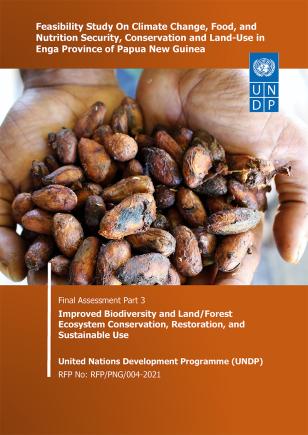Final Assessment Part 3: Improved biodiversity and land/forest ecosystem conservation, restoration and sustainable use

Final Assessment Part 3: Improved Biodiversity and Land/Forest Ecosystem Conservation, Restoration, and Sustainable Use
pdf (1MB)
DownloadFinal Assessment Part 3: Improved biodiversity and land/forest ecosystem conservation, restoration and sustainable use
December 18, 2022
This third component of the assessment focuses on enhanced action on conservation, restoration and sustainable use of high-value areas within the landscape.
More than 90% of Enga province area is covered by forest land (FinnOC, 2022), which presents opportunities for mitigation through reducing emissions from deforestation and forest degradation (REDD), supporting sustainable management conservation and enhancement of forest carbon stocks.
Enga province, located in PNG Highlands, is mainly covered by lower and upper montane forests and alpine and subalpine grasslands, which host a myriad of fauna and flora species. There are currently no official protected areas designated within Enga province.
PNG Guinea harbours an estimated 150,000 species of insects, 314 species of freshwater fish (82 endemics), 641 species of amphibians and reptiles (328 endemics), 740 species of birds (77 endemics), and 276 species of mammals (69 endemics).
The current status of species in Papua New Guinea includes one extinct, 36 critically endangered, 49 endangered, 365 vulnerable, and 288 near threatened (CBD 2022). Even though PNG has around 36.1 million hectares (ha) of forested land (78% of the total land area), the forest sector barely contributes to PNG’s economy.
Agroforestry is practised in all the districts in Enga, but mainly as a subsistence practice. Different cash crops and other crops are mixed with trees in Enga, including taro, coffee, banana, kaukau, beans, etc. A big proportion of forest resources are collected for firewood and timber, followed by edible plants and fruits. These products are mainly for self-sustaining families. Nevertheless, some of these (firewood, fruits, etc.) are also sold in markets, but seldomly throughout the year.
In Enga, deforestation and forest degradation are common – mainly due to agriculture subsistence clearing and population expansion. A total of 31353 ha were deforested in Enga Province between 2001-2020. People in Enga are aware of changes in vegetation cover and wildlife in the last years, mainly to increased economic activities and commonly believe Enga there are not enough conservation or protected areas.
There are seventy (70) species (including plants, animals, and fungi) under threat as per the IUCN red list, potentially occurring within 50 km of Enga province. Eight species (7 plants, one animal) are critically endangered (CR), 26 (21 plants, three animals and two fungi) are endangered (EN), and 36 (23 plants and 13 animals) are vulnerable (VU).
The main struggles that the government institutions face regarding forestry, biodiversity and conservation are a lack of funding, lack of manpower and lack of capacity building and training on biodiversity issues. The UNDP through the Strengthening Integrated Sustainable Landscape Management project will explore and support potential mitigation options in the forest sector, including:
- The conservation and protection of forests.
- Implementation of sustainable forest management (SFM).
- Implementation of Reduced Deforestation and Forest Degradation (REDD) schemes.
- Sustainable and participatory land-use planning and increase forest areas through reforestation and afforestation activities.

 Locations
Locations